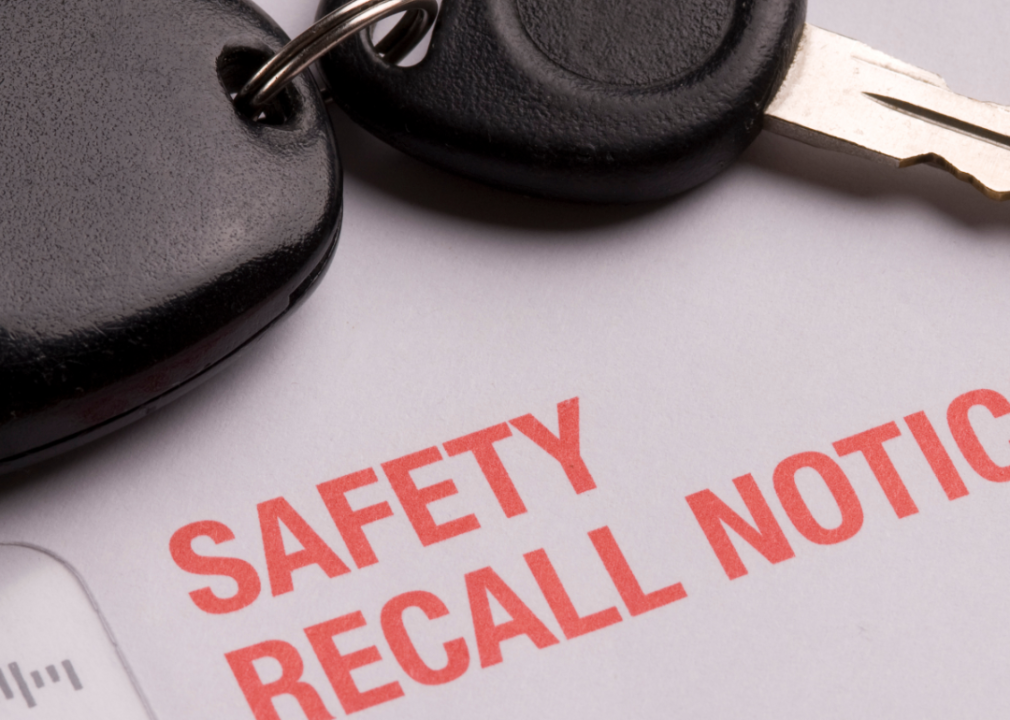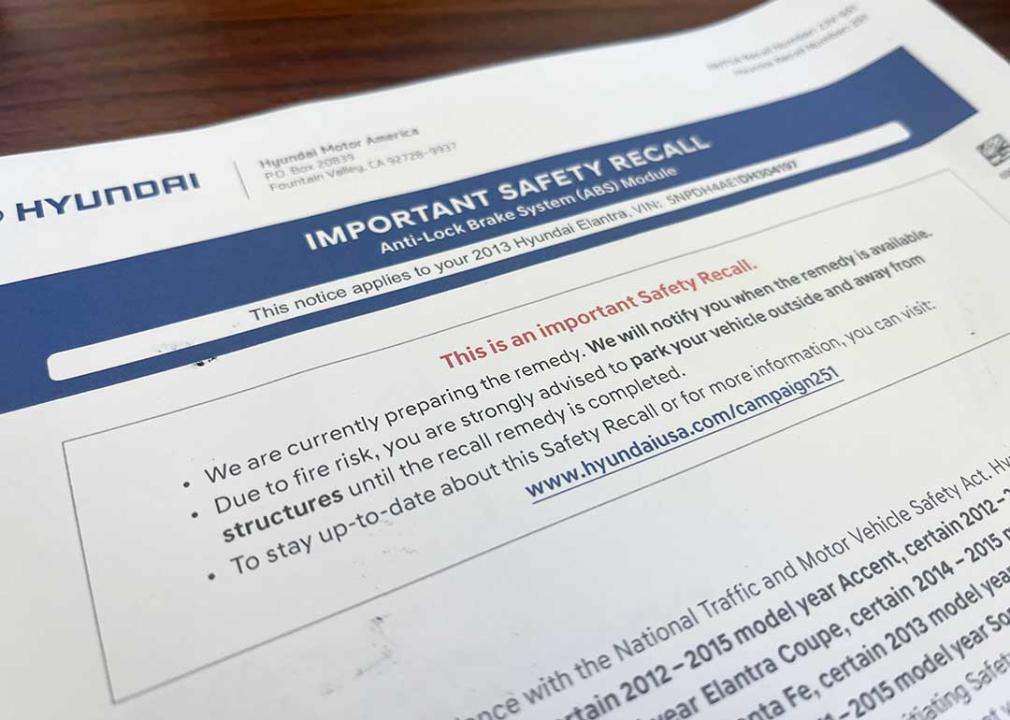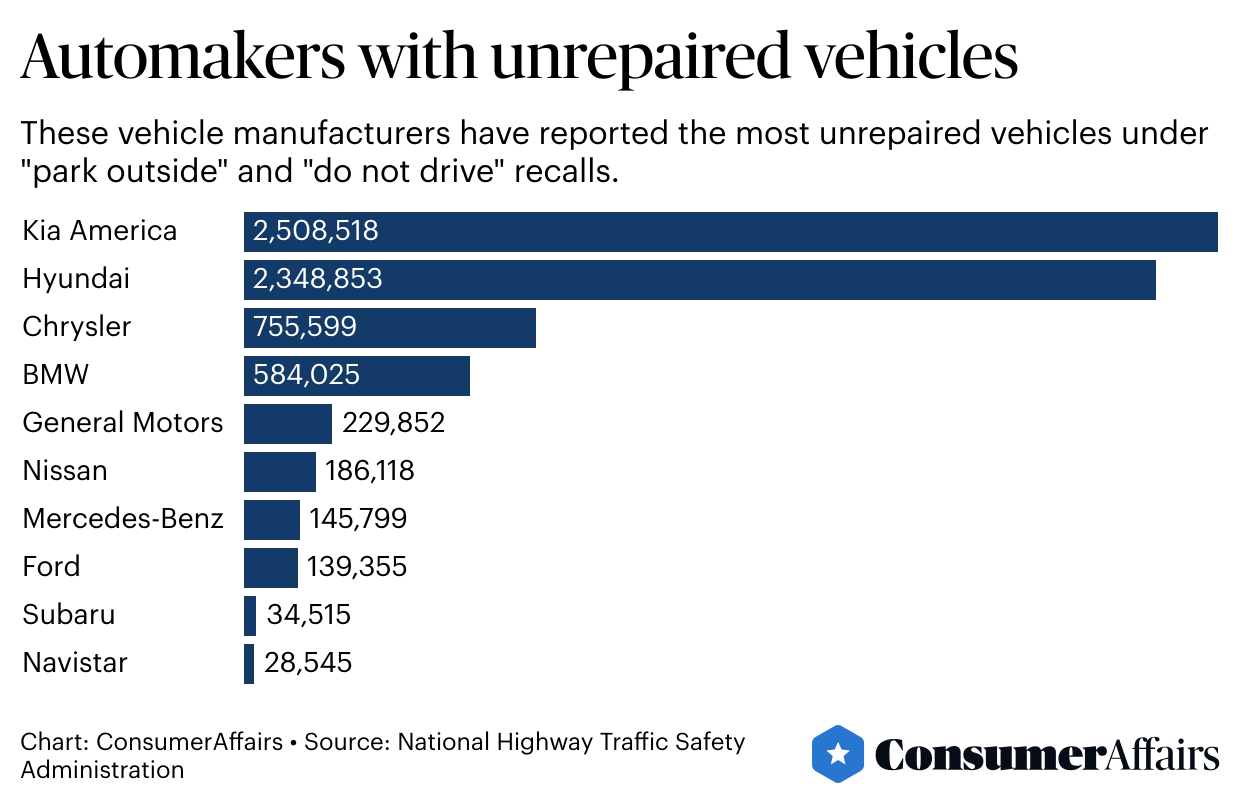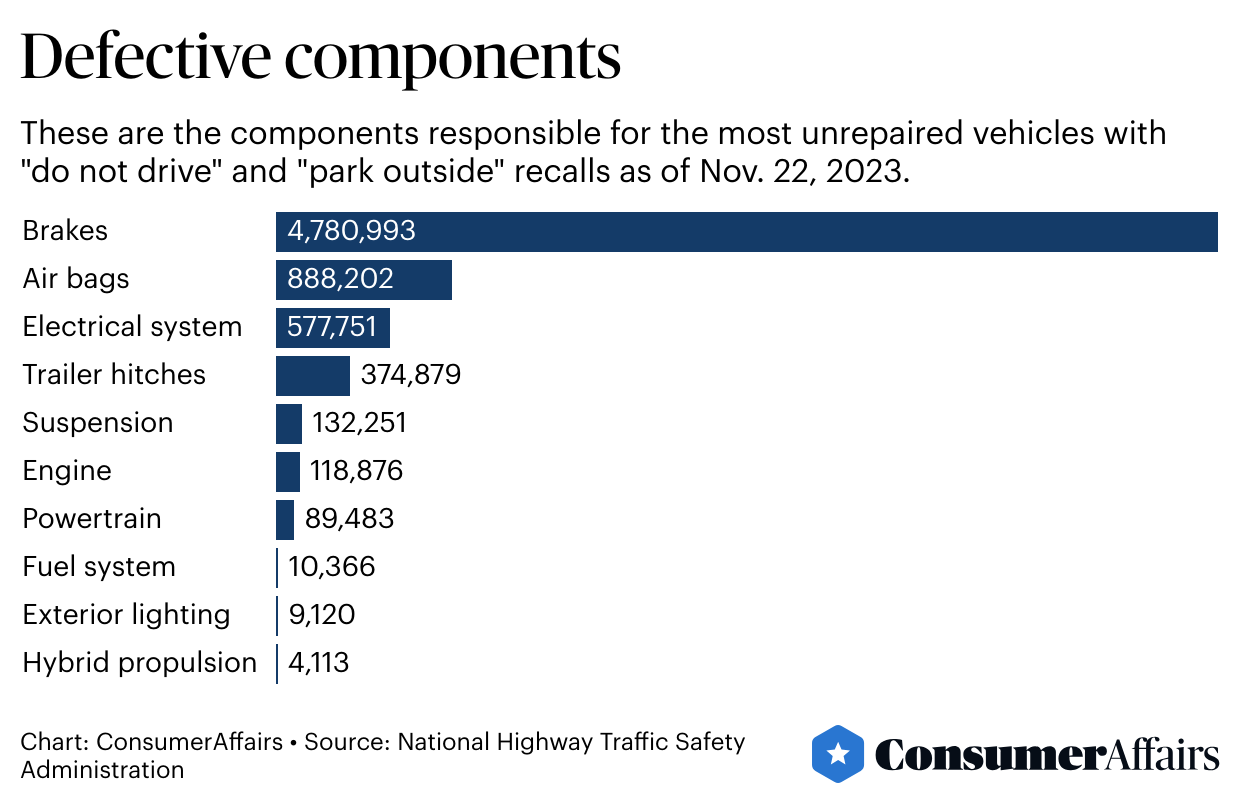Are you driving next to a death trap? Data shows millions of dangerous recalled vehicles are unrepaired

Canva
Are you driving next to a death trap? Data shows millions of dangerous recalled vehicles are unrepaired
safety recall notice
Denise Hughes is the owner of a car that could burst into flames at any moment. And yet, she’s still driving it.
“I’m like a sitting duck waiting for this car to explode,” Hughes, who drives a 2013 Hyundai Santa Fe, told ConsumerAffairs.
In September, Hughes and 1.6 million other Hyundai customers were warned that the anti-lock brake systems in their cars were at risk of short-circuiting. The problem could cause their vehicles to catch fire, even when they’re turned off.
Hyundai has reported at least 21 car fires and 22 “thermal incidents,” including visible smoke, burning, and melting, in the U.S. due to the defect.
“Due to fire risk, you are strongly advised to park your vehicles outside and away from safety structures until the recall remedy is completed,” Hyundai instructed drivers in its recall notice.
Officially, this advisory was referred to as a “park outside” recall. Along with “do not drive” recalls, the two are special kinds of auto recalls that instruct drivers on how to keep themselves safe from dangerous vehicles until they are repaired.
There’s just one problem — no remedy is available for Hughes’ Santa Fe. Hughes said she called safety regulators and Hyundai and was told there is nothing they can do for her until a fix is ready.
Hughes is doing her best to follow Hyundai’s directives in the meantime. She’s not allowed to park her SUV on the street outside her house, so she’s parking it in her garage with the door open. She has opted not to take it on long drives but has no choice but to start up the engine for doctor’s appointments. And, like many drivers, she can’t afford a replacement car.
The situation is almost unbearable.
“I’m at a loss for words,” Hughes said. “It’s sickening.”
Hughes is one of millions of car owners with dangerous safety recalls on their vehicles that have yet to be addressed, according to a ConsumerAffairs analysis, even though defective parts in these cars could cause fires, injuries and deaths. The unrepaired “do not drive” and “park outside” vehicles make up roughly 1 in 40, or 2.5%, of all vehicles in the U.S.
Key insights
- A total of 159 recalls affecting as many as 11.5 million vehicles have “do not drive” or “park outside” instructions, and up to 7 million of these vehicles have yet to be repaired.
- Owners of vehicles with “do not drive” recalls are less likely to get them fixed (45% unrepaired) than owners facing “park outside” recalls (38% unrepaired).
- Hyundai and Kia are the manufacturers that have issued the largest number of “do not drive” and “park outside” recalls.
- Brakes, air bags and electrical systems are the most commonly defective components in these dangerous recalls.
There’s no straightforward way to estimate how many of these vehicles are still being driven, since an unknown number have been discarded, exported, stolen, or scrapped. If, conservatively, about half of them are in operation, that means 1 in every 100 cars you pass on the road could be subject to an urgent safety recall that remains unaddressed.
The 7 million recalled vehicles include cars, buses, trucks, motorcycles, and even mobile homes. Some of them go unrepaired because of life circumstances — parenthood, illness and busy work schedules can push car repairs down the to-do list — and some because of wariness from drivers, who don’t trust dealerships and fear being sold additional, unnecessary repairs.
Others, like Hughes, are stuck driving their dangerous cars while they wait for automakers to come up with fixes.
Search ConsumerAffairs’ complete database of vehicles with “do not drive” and “park outside” recalls here.
Is your car on the “do not drive” list? Is your neighbor’s?
Not all drivers are aware of “do not drive” or “park outside” recalls on their cars. For one reason or another, a manufacturer’s recall alert hasn’t reached them, and they are unwittingly driving potential death traps, putting themselves and others at risk.
In perhaps the most infamous vehicle safety disaster to date, more than 40 million cars in the U.S. with Takata air bags were recalled from 2008 to 2020 because long-term exposure to high heat and humidity could cause them to explode when deploying, potentially piercing drivers and passengers with metal shrapnel. They have been linked to 27 deaths in the U.S.
But those horror stories haven’t been enough to convince all car owners a fix is necessary. Data from the National Highway Traffic Safety Administration show that 70% of cars with “do not drive” Takata air bag recalls have not been fixed.
That means as many as 888,000 of these vehicles could be out on the road somewhere, with the risk of the defect manifesting on the rise each day.
Jennifer Timian, the former chair of recalls at NHTSA, told ConsumerAffairs “park outside” and “do not drive” recalls are not necessarily more serious than other recalls. All recalls are issued because of unreasonable safety risks or failures to meet minimum safety standards, she explained.
“We don’t want to communicate that some recalls are less bad than others,” Timian said.
As an example, Toyota’s window switch defect, which caused short-circuiting that set cars on fire, didn’t lead to a “do not drive” or “park outside” label during a recall in 2015. Tesla’s recent recall of nearly its entire fleet of electric vehicles following more than 1,000 crashes linked to the autopilot feature doesn’t fall under the labels either.
Timian said repairing vehicles that have been recalled for any reason is essential for protecting the safety of everyone on the road, no matter the time and effort it takes.
“Just consider the cost of you getting hurt or injured or your family or friends getting hurt or injured in your car,” Timian said. “Think about that cost.”
![]()

Jill Castellano // ConsumerAffairs
What are “park outside” and “do not drive” recalls?
A “park outside” safety recall mailed to Hyundai drivers in November 2023.
Photo: A “park outside” safety recall mailed to Hyundai drivers in November 2023.
A rash of three fire hazard recalls were issued in March 2022. Kia, Hyundai, and Chrysler warned half a million customers that their cars could catch fire because of leaks inside their engines — even when the cars are parked and the keys are out of the ignition. The danger was so severe that drivers were instructed to park their cars outside to prevent their garages and homes from catching fire.
The series of recalls prompted NHTSA to make its warnings even more prominent online. “Urgent: Fire risk when parked” now appears bolded inside a red box on NHTSA’s webpages for “park outside” recalls.
Issues with electrical systems and brakes are responsible for the majority of the 50-plus “park outside” recalls that have been issued.
Another bold warning appears on recall alerts labeled “do not drive,” instructing car owners to “stop driving this vehicle immediately” due to safety hazards. Steering, suspension and braking issues are common causes of the more than 100 recalls issued with these instructions.
In some cases, manufacturers tow the vehicles to the dealership or repair them on-site, at customers’ homes, to prevent drivers from getting behind the wheel.
Up to 1.2 million unrepaired vehicles facing “do not drive” recalls and 5.8 million unrepaired vehicles facing “park outside” recalls could still be on the road, ConsumerAffairs found.
The “park outside” and “do not drive” labels offer important steps car owners can take to reduce their risk of serious property damage, injuries and deaths, even before a fix is available. The instructions can save lives.
The driver of a Chevrolet Bolt EV thankfully heeded the warning to park her car outside while she waited for a new car battery. She was one of more than 100,000 Bolt drivers alerted to a “park outside” recall due to a battery defect that caused at least 16 vehicles to burst into flames, including two that were parked and turned off.
On an early morning in Massachusetts this August, the driver’s Bolt seemed to spontaneously catch on fire outside her home. It took three hours for firefighters to quench the flames.
“If this vehicle had been parked in a garage, the results could have been disastrous,” the fire chief told reporters at the time.
More than 22,000 recalled electric Chevy Bolts have yet to be repaired.

ConsumerAffairs // National Highway Traffic Safety Administration
The biggest culprits to watch out for
table showing auto makers with most unrepaired vehicles
Mercedes-Benz recalled nearly 300,000 cars last May, warning customers that corrosion could lead to failing brakes.
“Owners are advised not to drive their vehicles until the remedy has been performed,” the recall notice said.
Yet only 50% of cars under the recall have been repaired.
Across all manufacturers, braking systems are responsible for the most “park outside” and “do not drive” recalls by far, with more than 7.3 million vehicles impacted from 34 recalls. Roughly 66% of them have gone unfixed.
Brakes, along with air bags and powertrains, also have low rates of repair — under 35%, ConsumerAffairs found.
Automakers with the most “park outside” and “do not drive” recalls:
- Kia: 12 recalls, 3.4 million affected vehicles, 2.5 million unrepaired
- Hyundai: 17 recalls, 4 million affected vehicles, 2.3 million unrepaired
- Chrysler: 9 recalls, 100,000 affected vehicles, 800,000 unrepaired
- BMW: 8 recalls, 800,000 affected vehicles, 600,000 unrepaired
- General Motors: 10 recalls, 600,000 affected vehicles, 200,000 unrepaired
- Nissan: 2 recalls, 600,000 affected vehicles, 200,000 unrepaired
- Mercedes-Benz: 3 recalls, 300,000 affected vehicles, 150,000 unrepaired
- Ford: 11 recalls, 300,000 affected vehicles, 140,000 unrepaired
- Subaru: 4 recalls, 300,000 affected vehicles, 40,000 unrepaired
- Navistar: 5 recalls, 40,000 affected vehicles, 30,000 unrepaired

ConsumerAffairs // National Highway Traffic Safety Administration
The most common defects to watch out for
a graph showing the components responsible for the most unrepaired vehicles
Experts speculate that the increasing complexity of vehicle manufacturing could be responsible for the bulk of recalls issued in recent years. Brakes, which once only required mechanical components to work properly, now also require complicated electrical components. And manufacturing air bags requires an understanding of pyrotechnics that goes well beyond what the early days of the auto industry could have imagined.
Defective components in vehicles with “do not drive” and “park outside” recalls:
- Brakes: 34 recalls, 7.3 million affected vehicles, 4.8 million unrepaired
- Air bags: 10 recalls, 1.3 million affected vehicles, 900,000 unrepaired
- Electrical systems: 25 recalls, 1 million affected vehicles, 600,000 unrepaired
- Trailer hitches: 5 recalls, 900,000 affected vehicles, 400,000 unrepaired
- Suspension: 16 recalls, 400,000 affected vehicles, 100,000 unrepaired
- Engine: 12 recalls, 200,000 affected vehicles, 100,000 unrepaired
- Powertrain: 11 recalls, 100,000 affected vehicles, 90,000 unrepaired
- Fuel system: 5 recalls, 20,000 affected vehicles, 10,000 unrepaired
- Exterior lighting: 1 recall, 20,000 affected vehicles, 9,000 unrepaired
- Hybrid propulsion system: 1 recall, 20,000 affected vehicles, 4,000 unrepaired
Two South Korean automakers, Hyundai and Kia, have been issuing massive “park outside” recalls for years due to failures of their hydraulic brake systems that can cause engine fires. The recalls have expanded to more makes and models over time, and they now encompass more than 6.3 million vehicles in the U.S.
About 4.3 million of them are not yet fixed, accounting for the majority of unrepaired cars in the data.
Ashley V., the owner of a 2013 Kia Optima, warned customers in a ConsumerAffairs review not to buy from the automaker. Vargo reported that despite being up to date on routine maintenance, the car failed on her in September 2022 when the acceleration stopped working mid-highway.
She pulled the car over, and once she stepped outside, it burst into flames.
“Please if you own a KIA, get rid of it,” she wrote. “Nothing but issues.”
The long road to repairs
Experts told ConsumerAffairs they were not surprised by the 7 million unrepaired vehicles facing urgent recalls. Researchers and industry professionals have been studying the issue for years.
“It’s a growing problem in the auto industry,” said Bruce Belzowski, the retired managing director of Automotive Futures at the University of Michigan Transportation Research Institute.
One University of Michigan survey from the institute found that 38% of people hesitant about fixing their recalled vehicles were worried the dealership would try to sell them on more repairs during the visit, and almost as many people said it would be difficult to give up their cars for repairs.
Both were true for Ethyl McCray, the owner of a 2016 Ford Fusion. She’s received several calls and letters about a recall on her car, warning her that a fluid leak could make her brakes less efficient, increasing the risk of a crash.
But McCray uses her car to get back and forth to work, and it has been hard to find the time and energy to get it fixed. Plus, she’s worried about what will happen when she brings it in for repairs.
“I understand that it’s very important,” she said. “I want them to correct it, but I’m scared they may mess something up and I have to pay more money to fix that.”
Automakers cover the cost of fixes for recalls, but drivers like McCray still worry about other costs that could come along with it.
Belzowski said this kind of distrust can be a major hurdle for car owners to overcome when considering whether to address a recall.
“Consumers usually leave the dealership after the car warranty is over,” he said. “There’s a whole body of repair shops that are a lot cheaper than the dealership, but none of these people do recalls. So when people are told they have to go to the dealer, they say, ‘Nah, I don’t want to do that.'”
A Mercedes-Benz driver who brought his car into the dealership for a fix on a brake recall told ConsumerAffairs in a review that the six-and-a-half-hour visit culminated in the mechanics trying to upsell him on $900 of additional repairs.
“The entire experience has given me cause to question past repairs that I was told were needed,” he wrote, cementing his review with a 1-star rating for the car company.
A 2023 ConsumerAffairs survey found 35% of people feel mechanics are always overcharging them, and another 45% said they sometimes feel they get overcharged.
And with the cost of auto repairs soaring, it can be hard to convince car owners to step foot in a repair shop. Air bag replacements now cost $1,000 to $2,000, and engine replacements can be priced upward of $4,000.
Pete DeVito, the automotive director for the United Service Workers Union, which represents mechanics working at dealerships, said many customers don’t take good care of their cars. That’s why dealers end up recommending upgrades and fixes when people bring in their vehicles, he said.
“These things should all be checked, all be fixed, because it’s a safety issue,” he said. “It’s the difference between life and death.”
DeVito said automakers can have difficulty communicating the importance of recalls to car owners. Some people miss out on the safety alerts entirely because they get lost in stacks of mail and tossed away.
“They think it’s advertising,” he said. “They get so much mail from dealers for new cars that they see it and disregard it.”
Data and methodology
ConsumerAffairs analyzed NHTSA vehicle recall data by manufacturer where “park outside” and “do not drive” instructions were issued.
The number of unrepaired vehicles in the data was calculated from each recall’s reported completion rates — the rate of recalled vehicles that have been repaired — and the total number of vehicles estimated to be affected by the recall.
Vehicles affected – (vehicles affected x completion rate) = unrepaired vehicles
Some vehicles may be subjected to several recalls in the data, and therefore the number of vehicles affected by a series of recalls are high-end estimates.
The data is current as of Nov. 21, 2023.
This story was produced by ConsumerAffairs and reviewed and distributed by Stacker Media.